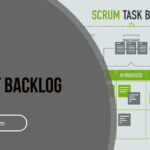The Product Owner adopts a management position and is often compared with the Project Manager role. The two roles are very similar, both have the same common goal; successfully completing the project.
In Scrum however, it is the Product Owner role that is most appropriate as Agile methodologies are not compatible with traditional Project Management roles.
Who is the Product Owner?
Positioned at the centre of the development cycle, the Product Owner has numerous key roles which are likely to vary depending on the environment.
Essentially, their task is to maximise the value of the products that the Scrum team create.
Roles and Responsibilities
The Product Owner leads in many areas of the process, their responsibilities include:
Vision definition
Product Owners communicate with stakeholders, such as business managers, customers and the project team. Communicating widely, with stakeholders at all levels helps to create clear goals that are aligned with the objectives of the business.
Leading on product development, Product Owners create the vision using their high-level perspective. This perspective ensures that the team works together effectively and from the same page, in an environment that is fast-paced and flexible.
The vision is maintained by the creation of a product roadmap, which also outlines the product direction throughout the process.
Product Backlog
The Product Owner is responsible for managing the team’s to-do list, ensuring that items are prioritised based on the strategy and objectives of the business.
When creating the list of backlog items, the Product Owner will also need to identify and map dependencies that will inform the development sequence.
It should be remembered however, that the to-do list is a live document and will need to be updated frequently as the project evolves. Because of the frequency of change, the list should be accessible to all stakeholders.
Prioritisation of needs
Managing the scope, budget and time frame according to the needs and objectives of the product’s stakeholders is a key responsibility of the Product Owner. Throughout the project’s life-cycle, they need to identify where flexibility exists, and which areas remain static.
Overseeing Product Development
This takes up a large portion of the Product Owner’s time. During each event they oversee the planning, refinement, review and sprint stages.
Firstly, they meet with stakeholders to identify the steps involved in the next iteration and organise them appropriately. This information is fed back to the project team where refinements are carried out and areas for improvement identified. Finally, the Product Owner supports the sprint.
Understanding Client Needs
The best Product Owners have in-depth market knowledge and are skilled communicators. Anticipating what the client needs makes the development process more effective to manage and is an area in which the Product Owner should be an expert.
Liaison
The Product Owner provides a link between the stakeholders and the project team, ensuring that there is buy-in from stakeholders, and clear instructions and deliverables relayed back to the team.
Evaluating Progress
Accountability for the project, including each individual stage falls to the Product Owner. They therefore take a leading role in evaluating the process of each iteration and decides whether the project can move on to the next step or repeat the process.
Essential Skills
There are four main skills that the Product Owner should possess:
Communication
As touched on above, the Product Owner should have well developed communication skills. This will encourage the effective flow of information from the stakeholders to the project team. Strong communication skills also enable the Product Owner to manage the project team, which is likely to be comprised of different personality types.
Commitment
The Product Owner is responsible for the overall outcome of the project. They must therefore be committed to the vision that they have created, the business and their team. Every meeting should be attended by the Product Owner and they must ensure that they collaborate with all members of the team and stakeholders.
Ability to say no
It is likely that the key executives of the business will have a number of ideas about the product and its development. To keep the timeframe on track, the project needs a strong Product Owner who is able to assess the feedback and say “no” during non-productive conversations, in a tactful manner.
Curiosity
When acting as liaison between the business and the project team, the Product Owner must be comfortable asking “why” questions to the business to understand their objectives better, and “how” questions to the project team to ensure that the end product matches the businesses expectations.
Becoming a Product Owner
The most common way to become a Product Owner is to be promoted from the inside. Promotions may be given to Business Analysts, particularly if IT is driving the project. Other senior members of the business may be asked to fulfil this role if they have significant experience of the processes driving the product.
The Product Owner role encapsulates marketing, business and technology. The increased rate of innovation means that many businesses have turned their focus to the user experience. Product Owners who are passionate about customers, have great leadership and business skills, and who know the market are extremely valuable to any business.
Additional Agile Resources
For an overview of Agile Project Roles and a free presentation, please visit the post Overview of Agile Project Management Roles.






